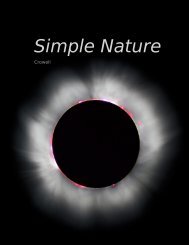The size of a radio antenna is closely related to ... - Light and Matter
The size of a radio antenna is closely related to ... - Light and Matter
The size of a radio antenna is closely related to ... - Light and Matter
You also want an ePaper? Increase the reach of your titles
YUMPU automatically turns print PDFs into web optimized ePapers that Google loves.
d / An uninverted reflection. <strong>The</strong><br />
reflected pulse <strong>is</strong> reversed front<br />
<strong>to</strong> back, but <strong>is</strong> not upside-down.<br />
e / An inverted reflection. <strong>The</strong><br />
reflected pulse <strong>is</strong> reversed both<br />
front <strong>to</strong> back <strong>and</strong> <strong>to</strong>p <strong>to</strong> bot<strong>to</strong>m.<br />
Whale songs traveling long d<strong>is</strong>tances example 9<br />
Sound waves travel at drastically different speeds through rock,<br />
water, <strong>and</strong> air. Whale songs are thus strongly reflected both at<br />
both the bot<strong>to</strong>m <strong>and</strong> the surface. <strong>The</strong> sound waves can travel<br />
hundreds <strong>of</strong> miles, bouncing repeatedly between the bot<strong>to</strong>m <strong>and</strong><br />
the surface, <strong>and</strong> still be detectable. Sadly, no<strong>is</strong>e pollution from<br />
ships has nearly shut down th<strong>is</strong> cetacean version <strong>of</strong> the internet.<br />
Long-d<strong>is</strong>tance <strong>radio</strong> communication example 10<br />
Radio communication can occur between stations on opposite<br />
sides <strong>of</strong> the planet. <strong>The</strong> mechan<strong>is</strong>m <strong>is</strong> entirely similar <strong>to</strong> the one<br />
explained in the previous example, but the three media involved<br />
are the earth, the atmosphere, <strong>and</strong> the ionosphere.<br />
self-check C<br />
Sonar <strong>is</strong> a method for ships <strong>and</strong> submarines <strong>to</strong> detect each other by<br />
producing sound waves <strong>and</strong> l<strong>is</strong>tening for echoes. What properties would<br />
an underwater object have <strong>to</strong> have in order <strong>to</strong> be inv<strong>is</strong>ible <strong>to</strong> sonar? ⊲<br />
Answer, p. 924<br />
<strong>The</strong> use <strong>of</strong> the word “reflection” naturally brings <strong>to</strong> mind the creation<br />
<strong>of</strong> an image by a mirror, but th<strong>is</strong> might be confusing, because<br />
we do not normally refer <strong>to</strong> “reflection” when we look at surfaces<br />
that are not shiny. Nevertheless, reflection <strong>is</strong> how we see the surfaces<br />
<strong>of</strong> all objects, not just pol<strong>is</strong>hed ones. When we look at a sidewalk,<br />
for example, we are actually seeing the reflecting <strong>of</strong> the sun from<br />
the concrete. <strong>The</strong> reason we don’t see an image <strong>of</strong> the sun at our<br />
feet <strong>is</strong> simply that the rough surface blurs the image so drastically.<br />
Inverted <strong>and</strong> uninverted reflections<br />
Notice how the pulse reflected back <strong>to</strong> the right in example c/2<br />
comes back upside-down, whereas the one reflected back <strong>to</strong> the left<br />
in c/3 returns in its original upright form. Th<strong>is</strong> <strong>is</strong> true for other<br />
waves as well. In general, there are two possible types <strong>of</strong> reflections,<br />
a reflection back in<strong>to</strong> a faster medium <strong>and</strong> a reflection back in<strong>to</strong> a<br />
slower medium. One type will always be an inverting reflection <strong>and</strong><br />
one noninverting.<br />
It’s important <strong>to</strong> realize that when we d<strong>is</strong>cuss inverted <strong>and</strong> uninverted<br />
reflections on a string, we are talking about whether the<br />
wave <strong>is</strong> flipped across the direction <strong>of</strong> motion (i.e., upside-down in<br />
these drawings). <strong>The</strong> reflected pulse will always be reversed front<br />
<strong>to</strong> back, as shown in figures d <strong>and</strong> e. Th<strong>is</strong> <strong>is</strong> because it <strong>is</strong> traveling<br />
in the other direction. <strong>The</strong> leading edge <strong>of</strong> the pulse <strong>is</strong> what gets<br />
reflected first, so it <strong>is</strong> still ahead when it starts back <strong>to</strong> the left —<br />
it’s just that “ahead” <strong>is</strong> now in the opposite direction.<br />
362 Chapter 6 Waves














